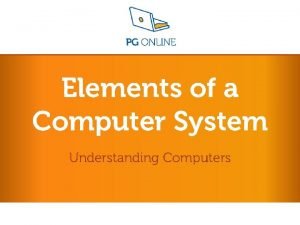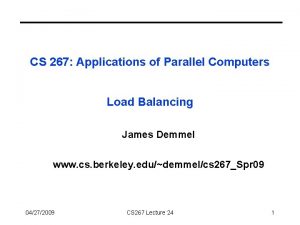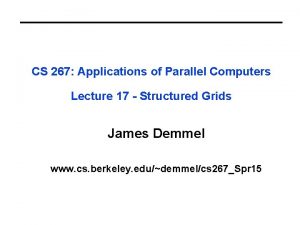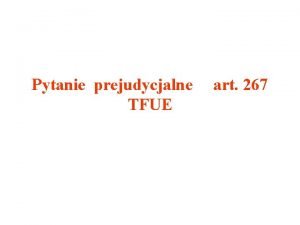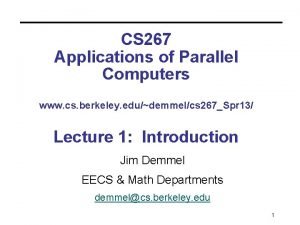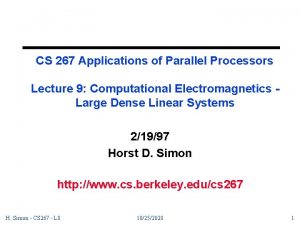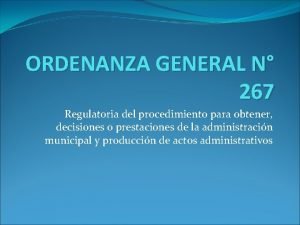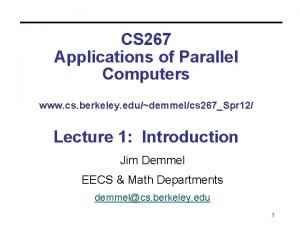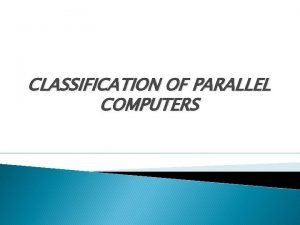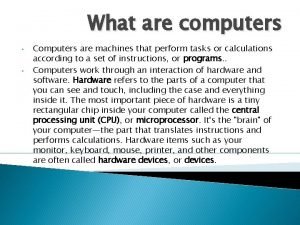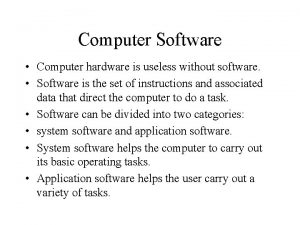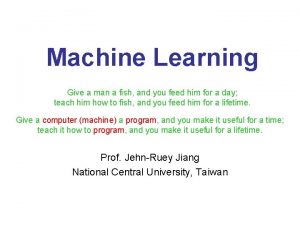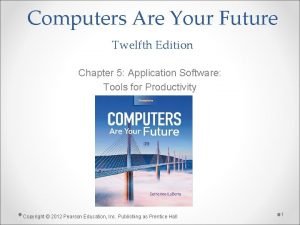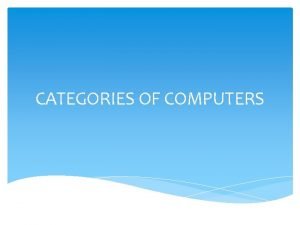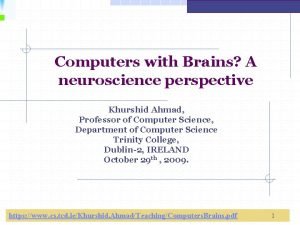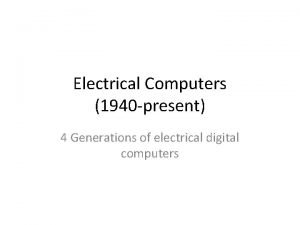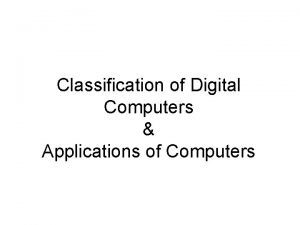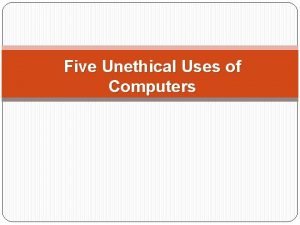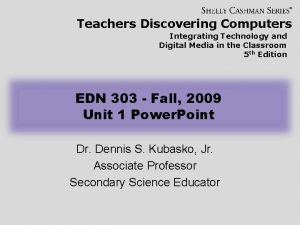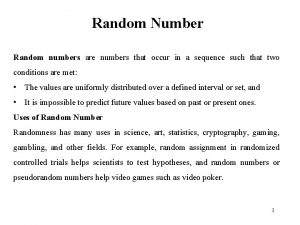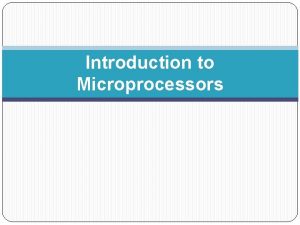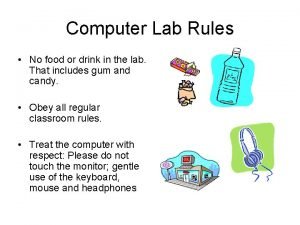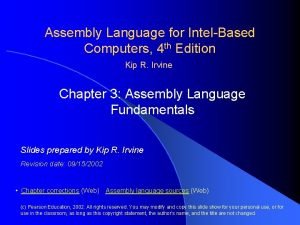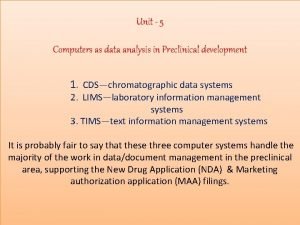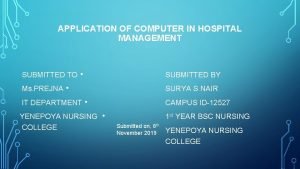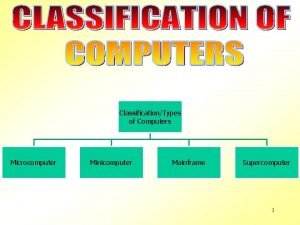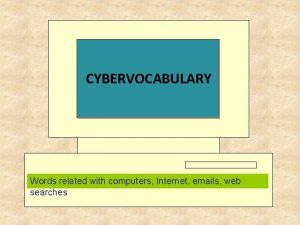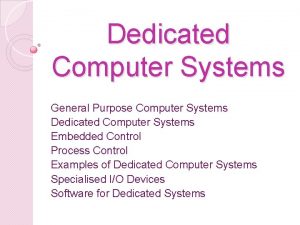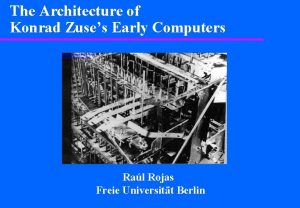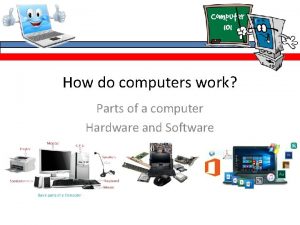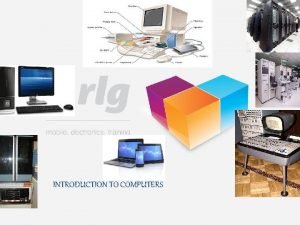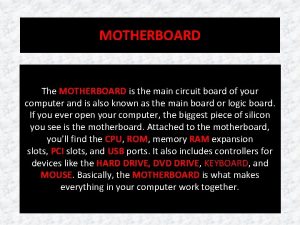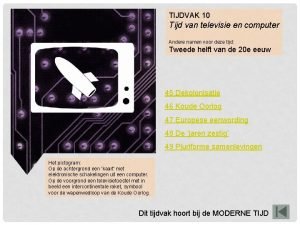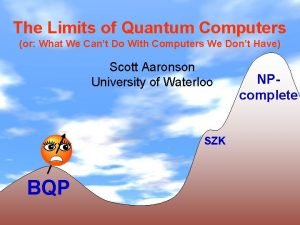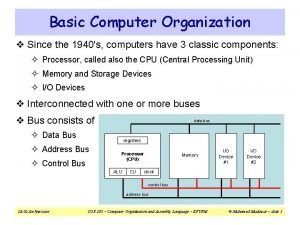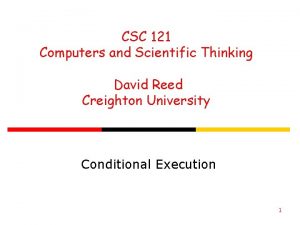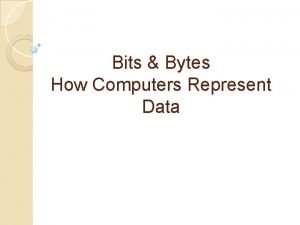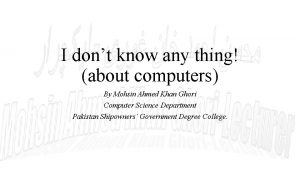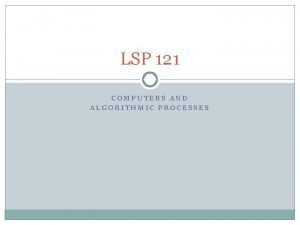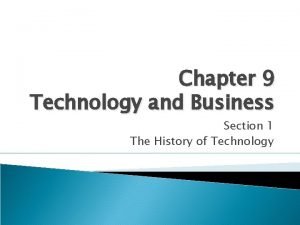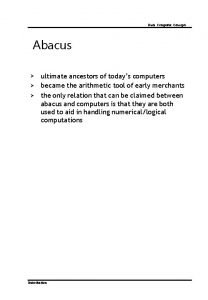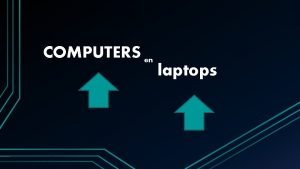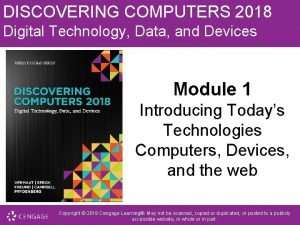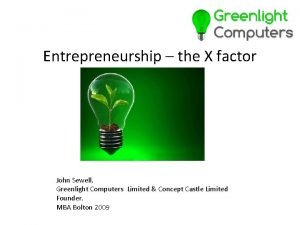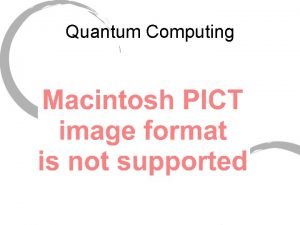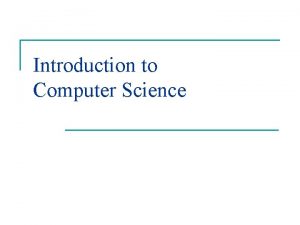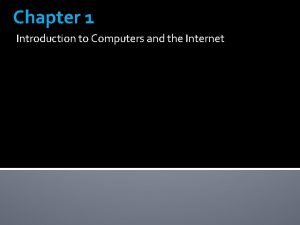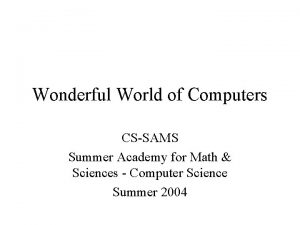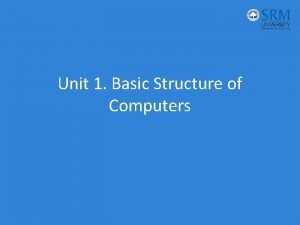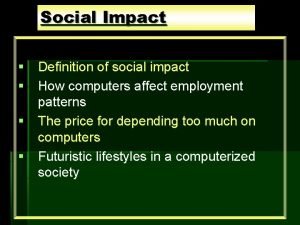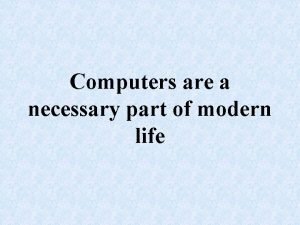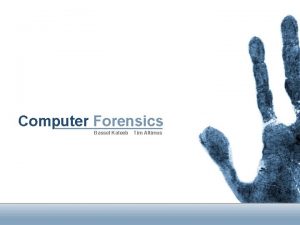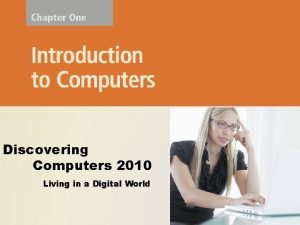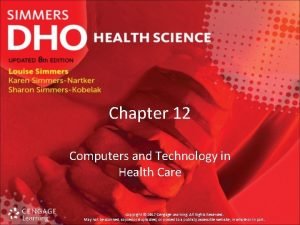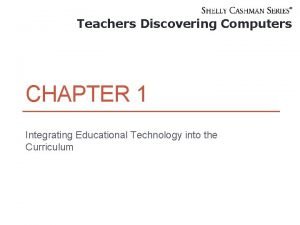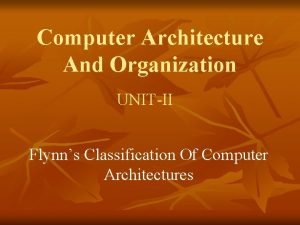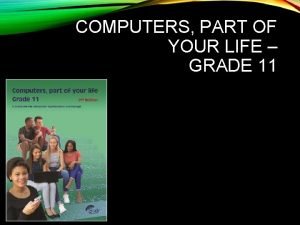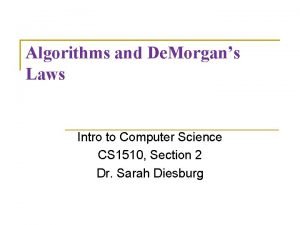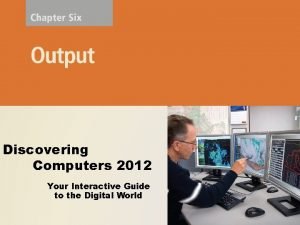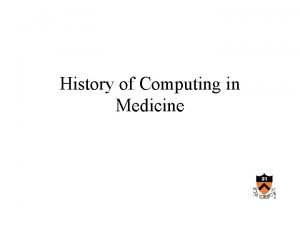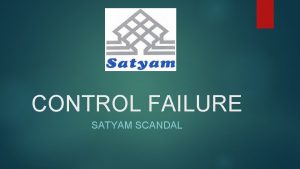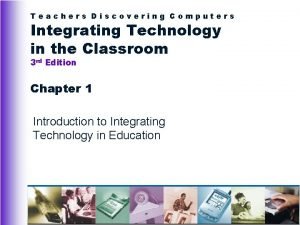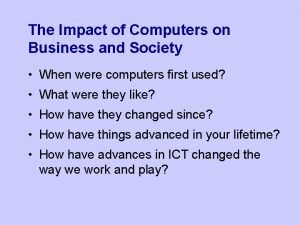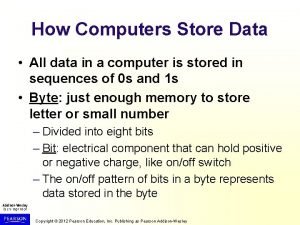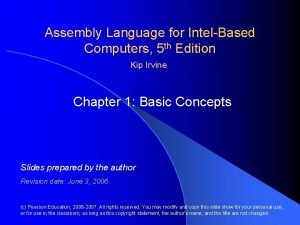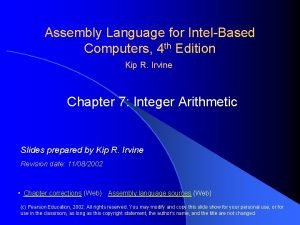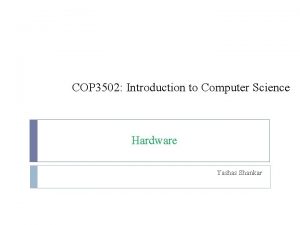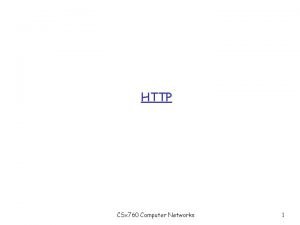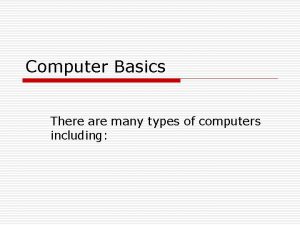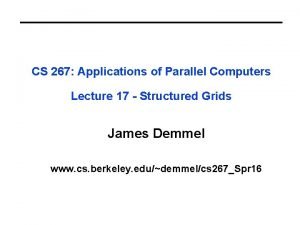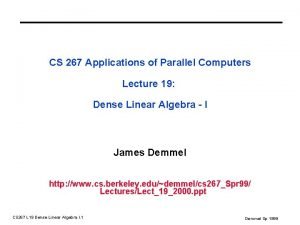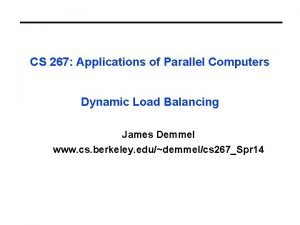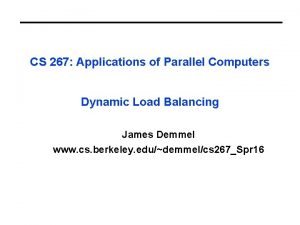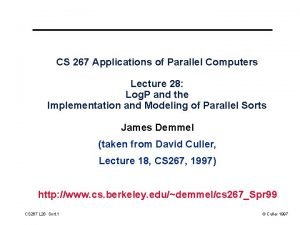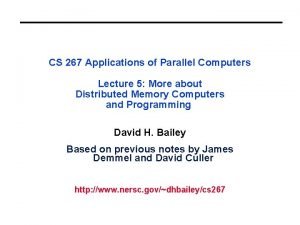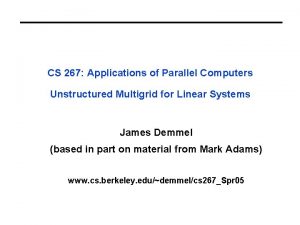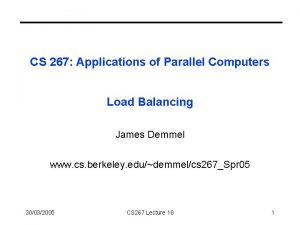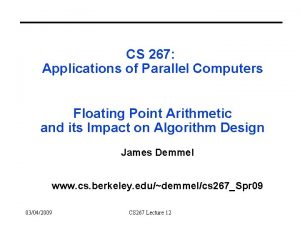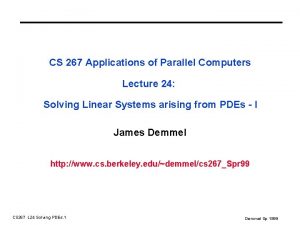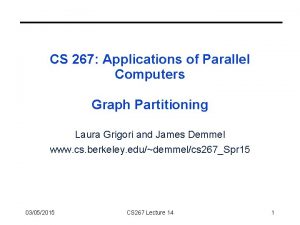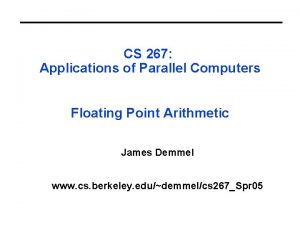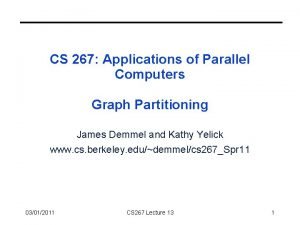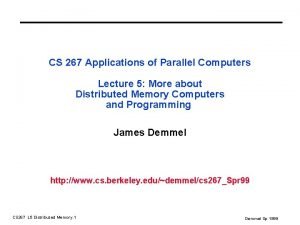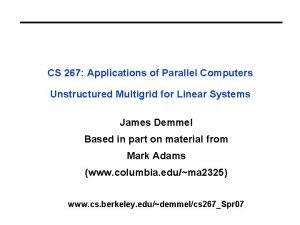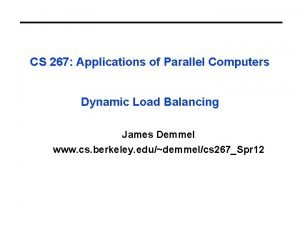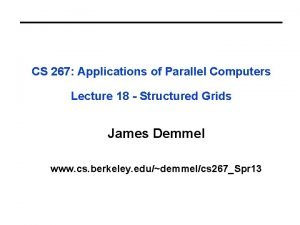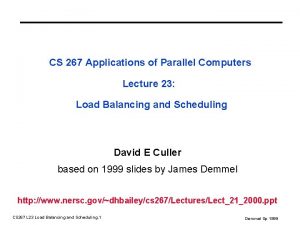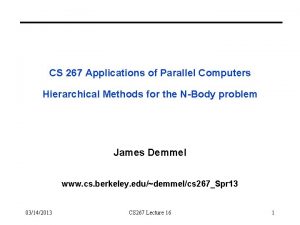CS 267 Applications of Parallel Computers www cs
























































































- Slides: 88

CS 267 Applications of Parallel Computers www. cs. berkeley. edu/~demmel/cs 267_Spr 12/ Lecture 1: Introduction Jim Demmel EECS & Math Departments demmel@cs. berkeley. edu 1

Outline all • Why powerful computers must be parallel processors Including your laptops and handhelds • Large Computational Science and Engineering (CSE) problems require powerful computers Commercial problems too • Why writing (fast) parallel programs is hard But things are improving • Structure of the course 01/17/2012 CS 267 - Lecture 1 2

Units of Measure • High Performance Computing (HPC) units are: - Flop: floating point operation, usually double precision unless noted - Flop/s: floating point operations per second - Bytes: size of data (a double precision floating point number is 8) • Typical sizes are millions, billions, trillions… Mega Giga Tera Peta Exa Mflop/s = 106 flop/sec Gflop/s = 109 flop/sec Tflop/s = 1012 flop/sec Pflop/s = 1015 flop/sec Eflop/s = 1018 flop/sec Mbyte = 220 = 1048576 ~ 106 bytes Gbyte = 230 ~ 109 bytes Tbyte = 240 ~ 1012 bytes Pbyte = 250 ~ 1015 bytes Ebyte = 260 ~ 1018 bytes Zetta Zflop/s = 1021 flop/sec Zbyte = 270 ~ 1021 bytes Yotta Yflop/s = 1024 flop/sec Ybyte = 280 ~ 1024 bytes • Current fastest (public) machine ~ 11 Pflop/s - Up-to-date list at www. top 500. org 01/17/2012 CS 267 - Lecture 1 3

all (2007) Why powerful computers are parallel circa 1991 -2006 4

Tunnel Vision by Experts • “I think there is a world market for maybe five computers. ” - Thomas Watson, chairman of IBM, 1943. • “There is no reason for any individual to have a computer in their home” - Ken Olson, president and founder of Digital Equipment Corporation, 1977. • “ 640 K [of memory] ought to be enough for anybody. ” - Bill Gates, chairman of Microsoft, 1981. • “On several recent occasions, I have been asked whether parallel computing will soon be relegated to the trash heap reserved for promising technologies that never quite make it. ” - Kennedy, CRPC Directory, 1994 01/17/2012 CS 267 - Lecture 1 Slide source: Warfield et al. 5

Technology Trends: Microprocessor Capacity Moore’s Law 2 X transistors/Chip Every 1. 5 years Called “Moore’s Law” Microprocessors have become smaller, denser, and more powerful. 01/17/2012 CS 267 - Lecture 1 Gordon Moore (co-founder of Intel) predicted in 1965 that the transistor density of semiconductor chips would double roughly every 18 months. Slide source: Jack Dongarra 6

Microprocessor Transistors / Clock (1970 -2000) 10000000 1000000 Transistors (Thousands) 100000 Frequency (MHz) 10000 100 10 1 0 1970 01/17/2012 1975 1980 1985 CS 267 - Lecture 1 1990 1995 2000 7

Impact of Device Shrinkage • What happens when the feature size (transistor size) shrinks by a factor of x ? • Clock rate goes up by x because wires are shorter - actually less than x, because of power consumption • Transistors per unit area goes up by x 2 • Die size also tends to increase - typically another factor of ~x • Raw computing power of the chip goes up by ~ x 4 ! - typically x 3 is devoted to either on-chip - parallelism: hidden parallelism such as ILP - locality: caches • So most programs x 3 times faster, without changing them 01/17/2012 CS 267 - Lecture 1 8

Manufacturing Issues Limit Performance Manufacturing costs and yield problems limit use of density • Moore’s 2 nd law (Rock’s law): costs go up Demo of 0. 06 micron CMOS Source: Forbes Magazine • Yield -What percentage of the chips are usable? -E. g. , Cell processor (PS 3) is sold with 7 out of 8 “on” to improve yield 9

Power Density Limits Serial Performance – Dynamic power is proportional to V 2 f. C – Increasing frequency (f) also increases supply voltage (V) cubic effect – Increasing cores increases capacitance (C) but only linearly – Save power by lowering clock speed Scaling clock speed (business as usual) will not work 10000 Sun’s Surface Source: Patrick Gelsinger, Shenkar Bokar, Intel Rocket 1000 Nozzle Power Density (W/cm 2) • Concurrent systems are more power efficient Nuclear 100 Reactor Hot Plate 8086 10 4004 8008 8080 P 6 8085 286 Pentium® 386 486 1 1970 1980 1990 2000 Year • High performance serial processors waste power - Speculation, dynamic dependence checking, etc. burn power - Implicit parallelism discovery • More transistors, but not faster serial processors 01/17/2012 CS 267 - Lecture 1 2010

Revolution in Processors 10000000 1000000 100000 10000 Transistors (Thousands) Frequency (MHz) Power Cores (W) Cores 1000 100 10 10 1 1 0 1970 • • 1975 1980 1985 1990 1995 2000 2005 2010 Chip density is continuing increase ~2 x every 2 years Clock speed is not Number of processor cores may double instead Power is under control, no longer growing 01/17/2012 CS 267 - Lecture 1 11

Parallelism in 2012? • These arguments are no longer theoretical • All major processor vendors are producing multicore chips - Every machine will soon be a parallel machine - To keep doubling performance, parallelism must double • Which (commercial) applications can use this parallelism? - Do they have to be rewritten from scratch? • Will all programmers have to be parallel programmers? - New software model needed - Try to hide complexity from most programmers – eventually - In the meantime, need to understand it • Computer industry betting on this big change, but does not have all the answers - Berkeley Par. Lab established to work on this 01/17/2012 CS 267 - Lecture 1 12

Memory is Not Keeping Pace Technology trends against a constant or increasing memory per core • Memory density is doubling every three years; processor logic is every two • Storage costs (dollars/Mbyte) are dropping gradually compared to logic costs Cost of Computation vs. Memory Source: David Turek, IBM Source: IBM Question: Can you double concurrency without doubling memory? • Strong scaling: fixed problem size, increase number of processors • Weak scaling: grow problem size proportionally to number of processors 01/17/2012 CS 267 - Lecture 1

The TOP 500 Project • Listing the 500 most powerful computers in the world • Yardstick: Rmax of Linpack - Solve Ax=b, dense problem, matrix is random - Dominated by dense matrix-matrix multiply • Update twice a year: - ISC’xy in June in Germany - SCxy in November in the U. S. • All information available from the TOP 500 web site at: www. top 500. org 01/17/2012 CS 267 - Lecture 1

38 th List: The TOP 10 Rank 1 2 3 4 Site RIKEN Advanced Institute for Computational Science National Super. Computer Center in Tianjin Oak Ridge National Laboratory National Supercomputing Centre in Shenzhen Manufacturer Fujitsu NUDT Cray Dawning GSIC, Tokyo Institute of Technology NEC/HP 6 DOE/NNSA/LANL/SNL Cray 7 NASA/Ames Research Center/NAS SGI 9 DOE/SC/ LBNL/NERSC Commissariat a l'Energie Atomique (CEA) 10 01/17/2012 DOE/NNSA/LANL K Computer SPARC 64 VIIIfx 2. 0 GHz, Tofu Interconnect Tianhe-1 A NUDT TH MPP, Country Cores Rmax Power [Pflops] [MW] Japan 795, 024 10. 51 12. 66 China 186, 368 2. 566 4. 04 Xeon 6 C, NVidia, FT-1000 8 C 5 8 Computer Jaguar Cray XT 5, HC 2. 6 GHz Nebulae TC 3600 Blade, Intel X 5650, NVidia Tesla C 2050 GPU TSUBAME-2 HP Pro. Liant, Xeon 6 C, NVidia, Linux/Windows Cielo Cray XE 6, 8 C 2. 4 GHz Pleiades SGI Altix ICE 8200 EX/8400 EX Hopper Cray XE 6, 6 C 2. 1 GHz Tera 100 Bull bullx super-node Bull S 6010/S 6030 Roadrunner IBM CS 267 - Lecture 1 Blade. Center QS 22/LS 21 Cray USA 224, 162 1. 759 6. 95 China 120, 640 1. 271 2. 58 Japan 73, 278 1. 192 1. 40 USA 142, 272 1. 110 3. 98 USA 111, 104 1. 088 4. 10 USA 153, 408 1. 054 2. 91 France 138. 368 1. 050 4. 59 USA 122, 400 1. 042 2. 34

Performance Development 74. 2 PFlop/s 100 Pflop/s 10. 51 PFlop/s 10 Pflop/s 100 Tflop/s SUM 10 Tflop/s 1 Tflop/s N=1 1. 17 TFlop/s 100 Gflop/s 10 Gflop/s 59. 7 GFlop/s N=500 1 Gflop/s 100 Mflop/s 01/17/2012 400 MFlop/s CS 267 - Lecture 1 50. 9 TFlop/s

Projected Performance Development 1 Eflop/s 100 Pflop/s 1 Pflop/s SUM 100 Tflop/s 10 Tflop/s N=1 1 Tflop/s 100 Gflop/s N=500 10 Gflop/s 100 Mflop/s 01/17/2012 CS 267 - Lecture 1

Core Count 01/17/2012 CS 267 - Lecture 1

Moore’s Law reinterpreted • Number of cores per chip can double every two years • Clock speed will not increase (possibly decrease) • Need to deal with systems with millions of concurrent threads • Need to deal with inter-chip parallelism as well as intra-chip parallelism 01/17/2012 CS 267 - Lecture 1

Outline all • Why powerful computers must be parallel processors Including your laptops and handhelds • Large CSE problems require powerful computers Commercial problems too • Why writing (fast) parallel programs is hard But things are improving • Structure of the course 01/17/2012 CS 267 - Lecture 1 20

Computational Science - News “An important development in sciences is occurring at the intersection of computer science and the sciences that has the potential to have a profound impact on science. It is a leap from the application of computing … to the integration of computer science concepts, tools, and theorems into the very fabric of science. ” -Science 2020 Report, March 2006 01/17/2012 CS 267 - Lecture 1 Nature, March 23, 2006 21

Drivers for Change • Continued exponential increase in computational power - Can simulate what theory and experiment can’t do • Continued exponential increase in experimental data - Moore’s Law applies to sensors too - Need to analyze all that data 01/17/2012 CS 267 - Lecture 1 22

Simulation: The Third Pillar of Science • Traditional scientific and engineering method: (1) Do theory or paper design (2) Perform experiments or build system Theory • Limitations: –Too difficult—build large wind tunnels Experiment Simulation –Too expensive—build a throw-away passenger jet –Too slow—wait for climate or galactic evolution –Too dangerous—weapons, drug design, climate experimentation • Computational science and engineering paradigm: (3) Use computers to simulate and analyze the phenomenon - Based on known physical laws and efficient numerical methods - Analyze simulation results with computational tools and methods beyond what is possible manually 01/17/2012 CS 267 - Lecture 1 23

Data Driven Science • Scientific data sets are growing exponentially - Ability to generate data is exceeding our ability to store and analyze - Simulation systems and some observational devices grow in capability with Moore’s Law • Petabyte (PB) data sets will soon be common: - Climate modeling: estimates of the next IPCC data is in 10 s of petabytes - Genome: JGI alone will have. 5 petabyte of data this year and double each year - Particle physics: LHC is projected to produce 16 petabytes of data per year - Astrophysics: LSST and others will produce 5 petabytes/year (via 3. 2 Gigapixel camera) • Create scientific communities with “Science Gateways” to data 01/17/2012 CS 267 - Lecture 1 24

Some Particularly Challenging Computations • Science - Global climate modeling Biology: genomics; protein folding; drug design Astrophysical modeling Computational Chemistry Computational Material Sciences and Nanosciences • Engineering - Semiconductor design Earthquake and structural modeling Computation fluid dynamics (airplane design) Combustion (engine design) Crash simulation • Business - Financial and economic modeling - Transaction processing, web services and search engines • Defense - Nuclear weapons -- test by simulations - Cryptography 01/17/2012 CS 267 - Lecture 1 25

Economic Impact of HPC • Airlines: - System-wide logistics optimization systems on parallel systems. - Savings: approx. $100 million per airline per year. • Automotive design: - Major automotive companies use large systems (500+ CPUs) for: - CAD-CAM, crash testing, structural integrity and aerodynamics. - One company has 500+ CPU parallel system. - Savings: approx. $1 billion per company per year. • Semiconductor industry: - Semiconductor firms use large systems (500+ CPUs) for - device electronics simulation and logic validation - Savings: approx. $1 billion per company per year. • Energy - Computational modeling improved performance of current nuclear power plants, equivalent to building two new power plants. 01/17/2012 CS 267 - Lecture 1 26

$5 B World Market in Technical Computing in 2004 Source: IDC 2004, from NRC Future of Supercomputing Report 01/17/2012 CS 267 - Lecture 1 27

What Supercomputers Do – Two Examples • Climate modeling - simulation replacing experiment that is too slow • Cosmic microwave background radition - analyzing massive amounts of data with new tools 01/17/2012 CS 267 - Lecture 1 28

Global Climate Modeling Problem • Problem is to compute: f(latitude, longitude, elevation, time) “weather” = (temperature, pressure, humidity, wind velocity) • Approach: - Discretize the domain, e. g. , a measurement point every 10 km - Devise an algorithm to predict weather at time t+dt given t • Uses: - Predict major events, e. g. , El Nino - Use in setting air emissions standards - Evaluate global warming scenarios Source: http: //www. epm. ornl. gov/chammp. html 01/17/2012 CS 267 - Lecture 1 29

Global Climate Modeling Computation • One piece is modeling the fluid flow in the atmosphere - Solve Navier-Stokes equations - Roughly 100 Flops per grid point with 1 minute timestep • Computational requirements: - To match real-time, need 5 x 1011 flops in 60 seconds = 8 Gflop/s Weather prediction (7 days in 24 hours) 56 Gflop/s Climate prediction (50 years in 30 days) 4. 8 Tflop/s To use in policy negotiations (50 years in 12 hours) 288 Tflop/s • To double the grid resolution, computation is 8 x to 16 x • State of the art models require integration of atmosphere, clouds, ocean, sea-ice, land models, plus possibly carbon cycle, geochemistry and more • Current models are coarser than this 01/17/2012 CS 267 - Lecture 1 30

High Resolution Climate Modeling on NERSC-3 – P. Duffy, et al. , LLNL 01/17/2012 CS 267 - Lecture 1 31

U. S. A. Hurricane Source: Data from M. Wehner, visualization by Prabhat, LBNL 01/17/2012 CS 267 - Lecture 1 32

NERSC User George Smoot wins 2006 Nobel Prize in Physics Smoot and Mather 1992 COBE Experiment showed anisotropy of CMB Cosmic Microwave Background Radiation (CMB): an image of the universe at 400, 000 years 01/17/2012 CS 267 - Lecture 1 33

The Current CMB Map source J. Borrill, LBNL • Unique imprint of primordial physics through the tiny anisotropies in temperature and polarization. • Extracting these Kelvin fluctuations from inherently noisy data is a serious computational challenge. 01/17/2012 CS 267 - Lecture 1 34

Evolution Of CMB Data Sets: Cost > O(Np^3 ) Experiment Nt Np Nb Limiting Data Notes COBE (1989) 2 x 109 6 x 103 3 x 101 Time BOOMERan. G (1998) 3 x 108 5 x 105 3 x 101 Pixel Balloon, 1 st HPC/NERSC (4 yr) WMAP (2001) 7 x 1010 4 x 107 1 x 103 ? Satellite, Analysis-bound Planck (2007) 5 x 1011 6 x 108 6 x 103 Time/ Pixel POLARBEAR (2007) 8 x 1012 6 x 106 1 x 103 Time CMBPol (~2020) 1014 109 104 Time/ Pixel Satellite, Workstation Satellite, Major HPC/DA effort Ground, NG-multiplexing Satellite, Early planning/design data compression 01/17/2012 CS 267 - Lecture 1 35

Which commercial applications require parallelism? Analyzed in detail in “Berkeley View” report www. eecs. berkeley. edu/Pubs/ Tech. Rpts/2006/EECS-2006183. html 01/17/2012 CS 267 - Lecture 1

What do commercial and CSE applications have in common? Motif/Dwarf: Common Computational Methods (Red Hot Blue Cool) 01/17/2012 CS 267 - Lecture 1

Outline all • Why powerful computers must be parallel processors Including your laptops and handhelds • Large CSE problems require powerful computers Commercial problems too • Why writing (fast) parallel programs is hard But things are improving • Structure of the course 01/17/2012 CS 267 - Lecture 1 38

Principles of Parallel Computing • Finding enough parallelism (Amdahl’s Law) • Granularity – how big should each parallel task be • Locality – moving data costs more than arithmetic • Load balance – don’t want 1 K processors to wait for one slow one • Coordination and synchronization – sharing data safely • Performance modeling/debugging/tuning All of these things makes parallel programming even harder than sequential programming. 01/17/2012 CS 267 - Lecture 1 39

“Automatic” Parallelism in Modern Machines • Bit level parallelism - within floating point operations, etc. • Instruction level parallelism (ILP) - multiple instructions execute per clock cycle • Memory system parallelism - overlap of memory operations with computation • OS parallelism - multiple jobs run in parallel on commodity SMPs Limits to all of these -- for very high performance, need user to identify, schedule and coordinate parallel tasks 01/17/2012 CS 267 - Lecture 1 40

Finding Enough Parallelism • Suppose only part of an application seems parallel • Amdahl’s law - let s be the fraction of work done sequentially, so (1 -s) is fraction parallelizable - P = number of processors Speedup(P) = Time(1)/Time(P) <= 1/(s + (1 -s)/P) <= 1/s • Even if the parallel part speeds up perfectly performance is limited by the sequential part • Top 500 list: currently fastest machine has P~705 K; 2 nd fastest has ~186 K+GPUs 01/17/2012 CS 267 - Lecture 1 41

Overhead of Parallelism • Given enough parallel work, this is the biggest barrier to getting desired speedup • Parallelism overheads include: - cost of starting a thread or process - cost of communicating shared data - cost of synchronizing - extra (redundant) computation • Each of these can be in the range of milliseconds (=millions of flops) on some systems • Tradeoff: Algorithm needs sufficiently large units of work to run fast in parallel (i. e. large granularity), but not so large that there is not enough parallel work 01/17/2012 CS 267 - Lecture 1 42

Locality and Parallelism Conventional Storage Proc Hierarchy Cache L 2 Cache Proc Cache L 2 Cache L 3 Cache Memory potential interconnects L 3 Cache • Large memories are slow, fast memories are small • Storage hierarchies are large and fast on average • Parallel processors, collectively, have large, fast cache - the slow accesses to “remote” data we call “communication” • Algorithm should do most work on local data 01/17/2012 CS 267 - Lecture 1 43

Processor-DRAM Gap (latency) Goal: find algorithms that minimize communication, not necessarily arithmetic CPU “Moore’s Law” 100 Processor-Memory Performance Gap: (grows 50% / year) DRAM 7%/yr. 10 1 µProc 60%/yr. 1980 1981 1982 1983 1984 1985 1986 1987 1988 1989 1990 1991 1992 1993 1994 1995 1996 1997 1998 1999 2000 Performance 1000 Time 01/17/2012 CS 267 - Lecture 1 44

Load Imbalance • Load imbalance is the time that some processors in the system are idle due to - insufficient parallelism (during that phase) - unequal size tasks • Examples of the latter - adapting to “interesting parts of a domain” - tree-structured computations - fundamentally unstructured problems • Algorithm needs to balance load - Sometimes can determine work load, divide up evenly, before starting - “Static Load Balancing” - Sometimes work load changes dynamically, need to rebalance dynamically - “Dynamic Load Balancing” 01/17/2012 CS 267 - Lecture 1 45

Parallel Software Eventually – Par. Lab view • 2 types of programmers 2 layers of software • Efficiency Layer (10% of programmers) - Expert programmers build Libraries implementing kernels, “Frameworks”, OS, …. - Highest fraction of peak performance possible • Productivity Layer (90% of programmers) - Domain experts / Non-expert programmers productively build parallel applications by composing frameworks & libraries - Hide as many details of machine, parallelism as possible - Willing to sacrifice some performance for productive programming • Expect students may want to work at either level - In the meantime, we all need to understand enough of the efficiency layer to use parallelism effectively 01/17/2012 CS 267 - Lecture 1 46

Outline all • Why powerful computers must be parallel processors Including your laptops and handhelds • Large CSE problems require powerful computers Commercial problems too • Why writing (fast) parallel programs is hard But things are improving • Structure of the course 01/17/2012 CS 267 - Lecture 1 47

Course Mechanics • Web page: http: //www. cs. berkeley. edu/~demmel/cs 267_Spr 12/ • Normally a mix of CS, EE, and other engineering and science students • Please fill out survey on web page (to be posted) • Grading: - Warmup assignment (homework 0 on the web) - Build a web page on an interest of yours in CSE - Three programming assignments - Final projects - Could be parallelizing an application, building or evaluating a tool, etc. - We encourage interdisciplinary teams, since this is the way parallel scientific software is generally built • Class computer accounts on Hopper, Dirac at NERSC - Fill out forms next time 01/17/2012 CS 267 - Lecture 1 48

Remote instruction – preparing an experiment • Lectures will be webcast, archived, as in past semesters - See class webpage for details • XSEDE is nationwide project supporting users of NSF supercomputer facilities - XSEDE plans to offer CS 267 to students nationwide - This semester, lectures will be editted, and homework ported to NSF supercomputer facilties - Challenges to “scaling up” education - Q&A – piazza or google groups? See class web page - Autograding – For correctness – run test cases (not as easy as it sounds) – For performance – timing on suitable platform - Ditto for Kurt Keutzer’s CS 194 class - Thanks for participating in the development of this experiment! 01/17/2012 CS 267 - Lecture 1 49

Rough List of Topics • Basics of computer architecture, memory hierarchies, performance • Parallel Programming Models and Machines - Shared Memory and Multithreading Distributed Memory and Message Passing Data parallelism, GPUs Cloud computing • Parallel languages and libraries - Shared memory threads and Open. MP - MPI - Other Languages , frameworks (UPC, CUDA, PETSC, “Pattern Language”, …) • “Seven Dwarfs” of Scientific Computing - Dense & Sparse Linear Algebra - Structured and Unstructured Grids - Spectral methods (FFTs) and Particle Methods • 6 additional motifs - Graph algorithms, Graphical models, Dynamic Programming, Branch & Bound, FSM, Logic • General techniques - Autotuning, Load balancing, performance tools • Applications: climate modeling, nanoscience, biology … (guest lecturers)50 CS 267 - Lecture 1 01/17/2012

Reading Materials • What does Google recommend? • Pointers on class web page • Must read: - “The Landscape of Parallel Processing Research: The View from Berkeley” - http: //www. eecs. berkeley. edu/Pubs/Tech. Rpts/2006/EECS-2006 -183. pdf • Some on-line texts: - Demmel’s notes from CS 267 Spring 1999, which are similar to 2000 and 2001. However, they contain links to html notes from 1996. - http: //www. cs. berkeley. edu/~demmel/cs 267_Spr 99/ - Ian Foster’s book, “Designing and Building Parallel Programming”. - http: //www-unix. mcs. anl. gov/dbpp/ • Potentially useful texts: - “Sourcebook for Parallel Computing”, by Dongarra, Foster, Fox, . . - A general overview of parallel computing methods - “Performance Optimization of Numerically Intensive Codes” by Stefan Goedecker and Adolfy Hoisie - This is a practical guide to optimization, mostly for those of you who have never done any optimization 01/17/2012 CS 267 - Lecture 1 51

Reading Materials (cont. ) • Recent books with papers about the current state of the art - David Bader (ed. ), “Petascale Computing, Algorithms and Applications”, Chapman & Hall/CRC, 2007 - Michael Heroux, Padma Ragahvan, Horst Simon (ed. ), ”Parallel Processing for Scientific Computing”, SIAM, 2006. - M. Sottile, T. Mattson, C. Rasmussen, Introduction to Concurrency in Programming Languages, Chapman & Hall/CRC, 2009. • More pointers on the web page 01/17/2012 CS 267 - Lecture 1 52

Instructors • Jim Demmel, EECS & Mathematics • GSIs: - Nick Knight, EECS - Brian Van Straalen, LBNL & EECS • Contact information on web page 01/17/2012 CS 267 - Lecture 1 53

Students • 64 registered or on the waitlist (57 grad, 7 undergrad) • 32 CS or EECS, rest from 01/17/2012 Applied Mathematics Applied Science & Technology (AS&T) Astronomy Bioengineering Civil & Environmental Engineering Industrial Eng and Operations Research Information Management Systems Integrative Biology Mathematics Mechanical Engineering Nuclear Engineering Physics CS 267 - Lecture 1 54

What you should get out of the course In depth understanding of: • When is parallel computing useful? • Understanding of parallel computing hardware options. • Overview of programming models (software) and tools, and experience using some of them • Some important parallel applications and the algorithms • Performance analysis and tuning • Exposure to various open research questions 01/17/2012 CS 267 - Lecture 1 55

Extra slides 56

Computational Science and Engineering (CSE) • CSE is a widely accepted label for an evolving field concerned with the science of and the engineering of systems and methodologies to solve computational problems arising throughout science and engineering • CSE is characterized by - Multi - disciplinary Multi - institutional Requiring high-end resources Large teams Focus on community software • CSE is not “just programming” (and not CS) • Fast computers necessary but not sufficient • Graduate program in CSE at UC Berkeley Reference: Petzold, L. , et al. , Graduate Education in CSE, SIAM Rev. , 43(2001), 163 -177 01/17/2012 CS 267 - Lecture 1 71

Sci. DAC - First Federal Program to Implement CSE • Sci. DAC (Scientific Discovery through Advanced Computing) program created in 2001 – About $50 M annual funding – Berkeley (LBNL+UCB) largest recipient of Sci. DAC funding Nanoscience Biology 01/17/2012 Global Climate Combustion CS 267 - Lecture 1 Astrophysics 72

Transaction Processing (mar. 15, 1996) • Parallelism is natural in relational operators: select, join, etc. • Many difficult issues: data partitioning, locking, threading. 01/17/2012 CS 267 - Lecture 1 73

SIA Projections for Microprocessors 1000 100 Feature Size (microns) 10 Transistors per chip x 106 1 0. 1 2010 2007 2004 2001 1998 0. 01 1995 Feature Size (microns) & Million Transistors per chip Compute power ~1/(Feature Size)3 Year of Introduction based on F. S. Preston, 1997 01/17/2012 CS 267 - Lecture 1 74

Much of the Performance is from Parallelism Thread-Level Parallelism? Instruction-Level Parallelism Bit-Level Parallelism 01/17/2012 CS 267 - Lecture 1 75

Performance on Linpack Benchmark www. top 500. org Gflops Nov 2004: IBM Blue Gene L, 70. 7 Tflops Rmax 01/17/2012 CS 267 - Lecture 1 76

Performance Projection 6 -8 years 8 -10 years Slide by Erich Strohmaier, LBNL 01/17/2012 CS 267 - Lecture 1 77

Performance Projection Slide by Erich Strohmaier, LBNL 01/17/2012 CS 267 - Lecture 1 78

Concurrency Levels Slide by Erich Strohmaier, LBNL 01/17/2012 CS 267 - Lecture 1 79

Concurrency Levels- There is a Massively Parallel System Also in Your Future Slide by Erich Strohmaier, LBNL 01/17/2012 CS 267 - Lecture 1 80

Supercomputing Today • Microprocessors have made desktop computing in 2007 what supercomputing was in 1995. • Massive Parallelism has changed the “high-end” completely. • Most of today's standard supercomputing architecture are “hybrids”, clusters built out of commodity microprocessors and custom interconnects. • The microprocessor revolution will continue with little attenuation for at least another 10 years • The future will be massively parallel, based on multicore 81

Outline all • Why powerful computers must be parallel computers Including your laptop and handhelds • Large important problems require powerful computers Even computer games • Why writing (fast) parallel programs is hard But things are improving • Principles of parallel computing performance • Structure of the course 01/17/2012 CS 267 - Lecture 1 82

Is Multicore the Correct Response? • Kurt Keutzer: “This shift toward increasing parallelism is not a triumphant stride forward based on breakthroughs in novel software and architectures for parallelism; instead, this plunge into parallelism is actually a retreat from even greater challenges that thwart efficient silicon implementation of traditional uniprocessor architectures. ” • David Patterson: “Industry has already thrown the hail-mary pass. . . But nobody is running yet. ” 01/17/2012 CS 267 - Lecture 1 83

Community Reaction • Desktop/Consumer - Move from almost no parallelism to parallelism But industry is already betting on parallelism (multicore) for its future • HPC - Modest growth in parallelism is giving way to exponential growth curve Have Parallel programming tools and algorithms, but driven by experts (unlikely to be adopted by broader software development community) • The first hardware is here, but have no consensus on hardware details or software model necessary to program it - 01/17/2012 Reaction: Widespread Panic! CS 267 - Lecture 1 84

The View from Berkeley: Seven Questions for Parallelism • Applications: 1. What are the apps? 2. What are kernels of apps? • Hardware: 3. What are the HW building blocks? 4. How to connect them? • Programming Model / Systems Software: 5. How to describe apps and kernels? 6. How to program the HW? • Evaluation: 7. How to measure success? (Inspired by a view of the Golden Gate Bridge from Berkeley) http: //www. eecs. berkeley. edu/Pubs/Tech. Rpts/2006/EECS-2006 -183. pdf 01/17/2012 CS 267 - Lecture 1 85

Applications • Applications: 1. What are the apps? CS 267 focus is here 2. What are kernels of apps? • Hardware: 3. What are the HW building blocks? 4. How to connect them? • Programming Model / Systems Software: 5. How to describe apps and kernels? 6. How to program the HW? • Evaluation: 7. How to measure success? (Inspired by a view of the Golden Gate Bridge from Berkeley) 01/17/2012 CS 267 - Lecture 1 86

Much Ado about Dwarves Motifs High-end simulation in the physical sciences = 7 numerical methods: 1. Structured Grids (including locally structured grids, e. g. Adaptive • Mesh Refinement) Benchmarks enable assessment of hardware performance improvements 2. Unstructured Grids • The problem with benchmarks is that they enshrine an implementation 3. Fast Fourier Transform 4. Dense Linear Algebra • At this point in time, we need flexibility to innovate both implementation and the hardware they run on! 5. Sparse Linear Algebra 6. Particles 7. Monte Carlo • Dwarves provide that necessary abstraction Map Reduce Slide from “Defining Software Requirements for Scientific Computing”, Phillip Colella, 2004 01/17/2012 CS 267 - Lecture 1 87

Do dwarfs work well outside HPC? • Examine effectiveness 7 dwarfs elsewhere 1. Embedded Computing (EEMBC benchmark) 2. Desktop/Server Computing (SPEC 2006) 3. Data Base / Text Mining Software - Advice from Jim Gray of Microsoft and Joe Hellerstein of UC 4. Games/Graphics/Vision 5. Machine Learning - Advice from Mike Jordan and Dan Klein of UC Berkeley • 01/17/2012 Result: Added 7 more dwarfs, revised 2 original dwarfs, renumbered list CS 267 - Lecture 1 88

Destination is Manycore • We need revolution, not evolution • Software or architecture alone can’t fix parallel programming problem, need innovations in both • “Multicore” 2 X cores per generation: 2, 4, 8, … • “Manycore” 100 s is highest performance per unit area, and per Watt, then 2 X per generation: 64, 128, 256, 512, 1024 … • Multicore architectures & Programming Models good for 2 to 32 cores won’t evolve to Manycore systems of 1000’s of processors Desperately need HW/SW models that work for Manycore or will run out of steam (as ILP ran out of steam at 4 instructions) 01/17/2012 CS 267 - Lecture 1 89

Units of Measure in HPC • High Performance Computing (HPC) units are: - Flop: floating point operation - Flops/s: floating point operations per second - Bytes: size of data (a double precision floating point number is 8) • Typical sizes are millions, billions, trillions… Mega Giga Tera Peta Exa Mflop/s = 106 flop/sec Gflop/s = 109 flop/sec Tflop/s = 1012 flop/sec Pflop/s = 1015 flop/sec Eflop/s = 1018 flop/sec Mbyte = 220 = 1048576 ~ 106 bytes Gbyte = 230 ~ 109 bytes Tbyte = 240 ~ 1012 bytes Pbyte = 250 ~ 1015 bytes Ebyte = 260 ~ 1018 bytes Zetta Zflop/s = 1021 flop/sec Zbyte = 270 ~ 1021 bytes Yotta Yflop/s = 1024 flop/sec Ybyte = 280 ~ 1024 bytes • See www. top 500. org for current list of fastest machines 01/17/2012 CS 267 - Lecture 1 90

30 th List: The TOP 10 Manufacturer 1 IBM 2 IBM 3 SGI 4 HP 5 HP 6 3 7 2 8 4 Sandia/Cray IBM 9 Cray 10 5 IBM Computer Blue. Gene/L e. Server Blue Gene JUGENE Blue. Gene/P Solution Rmax Installation Site Country Year #Cores 478. 2 DOE/NNSA/LLNL USA 2007 212, 992 167. 3 Forschungszentrum Juelich Germany 2007 65, 536 USA 2007 14, 336 India 2007 14, 240 Sweden 2007 13, 728 [TF/s] New Mexico Computing Applications Center Computational Research Cluster Platform 3000 BL 460 c 117. 9 Laboratories, TATA SONS Swedish Government Cluster Platform 3000 BL 460 c 102. 8 Agency SGI Altix ICE 8200 Red Storm Cray XT 3 Jaguar Cray XT 3/XT 4 BGW e. Server Blue Gene Franklin Cray XT 4 New York Blue e. Server Blue Gene 126. 9 102. 2 DOE/NNSA/Sandia USA 2006 26, 569 101. 7 DOE/ORNL USA 2007 23, 016 91. 29 IBM Thomas Watson USA 2005 40, 960 85. 37 NERSC/LBNL USA 2007 19, 320 82. 16 Stony Brook/BNL USA 2007 36, 864 page 91

New 100 Tflops Cray XT-4 at NERSC Cray XT-4 “Franklin” 19, 344 compute cores 102 Tflop/sec peak 39 TB memory 350 TB usable disk space 50 PB storage archive NERSC is enabling new science 01/17/2012 CS 267 - Lecture 1 92

Performance Development page 93

Signpost System in 2005 IBM BG/L @ LLNL • 700 MHz • 65, 536 nodes • 180 (360) Tflop/s peak • 32 TB memory • 135 Tflop/s LINPACK • 250 m 2 floor space • 1. 8 MW power 01/17/2012 CS 267 - Lecture 1 94

Outline all • Why powerful computers must be parallel processors Including your laptop • Large important problems require powerful computers Even computer games • Why writing (fast) parallel programs is hard • Principles of parallel computing performance • Structure of the course 01/17/2012 CS 267 - Lecture 1 95

Why we need powerful computers 96

New Science Question: Hurricane Statistics What is the effect of different climate scenarios on number and severity of tropical storms? Northwest Pacific 1979 1980 1981 1982 Obs >25 ~30 40 ~6 ~12 ? Basin Atlantic Basin Work in progress—results to be published Source: M. Wehner, LBNL 01/17/2012 CS 267 - Lecture 1 97

CMB Computing at NERSC • CMB data analysis presents a significant and growing computational challenge, requiring - well-controlled approximate algorithms - efficient massively parallel implementations - long-term access to the best HPC resources • DOE/NERSC has become the leading HPC facility in the world for CMB data analysis - O(1, 000) CPU-hours/year - O(10) Tb project disk space - O(10) experiments & O(100) users (rolling) source J. Borrill, LBNL 01/17/2012 CS 267 - Lecture 1 98

Evolution Of CMB Satellite Maps 01/17/2012 CS 267 - Lecture 1 99

Algorithms & Flop-Scaling - Exact maximum likelihood : O(Np 3) PCG maximum likelihood : O(Ni Nt log Nt) Scan-specific, e. g. . destriping : O(Nt log Nt) Naïve : O(Nt) Accuracy Speed • Map-making - Iterative maximum likelihood : O(Ni Nb Np 3) - Monte Carlo pseudo-spectral : - Time domain : O(Nr Ni Nt log Nt), O(Nr lmax 3) - Pixel domain : O(Nr Nt) - Simulations Accuracy Speed • Power Spectrum estimation – exact simulation > approximate analysis ! 01/17/2012 CS 267 - Lecture 1 100

CMB is Characteristic for CSE Projects • Petaflop/s and beyond computing requirements • Algorithm and software requirements • Use of new technology, e. g. NGF • Service to a large international community • Exciting science 01/17/2012 CS 267 - Lecture 1 101

Parallel Browser (Ras Bodik) • Web 2. 0: Browser plays role of traditional OS - Resource sharing and allocation, Protection • Goal: Desktop quality browsing on handhelds - Enabled by 4 G networks, better output devices • Bottlenecks to parallelize - Parsing, Rendering, Scripting • “Skip. Jax” - Parallel replacement for Java. Script/AJAX - Based on Brown’s Flap. Jax 01/17/2012 CS 267 - Lecture 1 102
 Elements of computer
Elements of computer Cs 267
Cs 267 Cs 267
Cs 267 Cmput 267
Cmput 267 Art. 267 tfue
Art. 267 tfue Cs 267 berkeley
Cs 267 berkeley Cs 267
Cs 267 Ordenanza general 267
Ordenanza general 267 Cs 267
Cs 267 Classification of parallel computers
Classification of parallel computers Parallelism rules
Parallelism rules Shift register truth table
Shift register truth table Parallelosm
Parallelosm Parrelell structure
Parrelell structure Like parallel forces images
Like parallel forces images Parallel structure means
Parallel structure means Inner terminus
Inner terminus Computers are machines that
Computers are machines that A computer without software is
A computer without software is Fish processing computers
Fish processing computers Computers are your future 12th edition pdf
Computers are your future 12th edition pdf What are seven categories of computers
What are seven categories of computers Computers
Computers Edvac full form
Edvac full form Classification of computer
Classification of computer Unethical uses of computers
Unethical uses of computers Uses of computers
Uses of computers How do computers get random numbers
How do computers get random numbers Characteristics of microprocessor
Characteristics of microprocessor No food or drink near computers
No food or drink near computers Assembly language for intel-based computers
Assembly language for intel-based computers Discuss the role of computers in preclinical development
Discuss the role of computers in preclinical development Application of computer in hospital
Application of computer in hospital Poems about computer science
Poems about computer science Fat computers
Fat computers Applications of mini computer
Applications of mini computer Words related to computers and the internet
Words related to computers and the internet Computers are amazing
Computers are amazing Dedicated system
Dedicated system Basic structure of computer in computer organization
Basic structure of computer in computer organization Z 3
Z 3 Basic components of computer
Basic components of computer How do computers work
How do computers work 000010111010
000010111010 Is micro computer
Is micro computer The main circuit board of the computer
The main circuit board of the computer Tijdvak 10
Tijdvak 10 The limits of quantum computers
The limits of quantum computers Chapter 1 introduction to computers and programming
Chapter 1 introduction to computers and programming Basic computer organization
Basic computer organization 121 computers
121 computers Giga tera
Giga tera What is a computer
What is a computer Third gen computers
Third gen computers 121 computers
121 computers Computers are amazing
Computers are amazing Businesses often call their stores and warehouses
Businesses often call their stores and warehouses The ultimate ancestor of today's computer
The ultimate ancestor of today's computer Wanneer vond bill moggridge de eerste laptop uit
Wanneer vond bill moggridge de eerste laptop uit Discovering computers 2018 ppt download
Discovering computers 2018 ppt download Greenlight computers
Greenlight computers How does computers work
How does computers work What can computers do
What can computers do Benefits of computer oriented society
Benefits of computer oriented society How have computers changed over time
How have computers changed over time The wonderful world of computers
The wonderful world of computers Basic structure of computers in computer organization
Basic structure of computers in computer organization Social impact of computers
Social impact of computers Computers in modern life
Computers in modern life Bassel computers
Bassel computers Computers 2010
Computers 2010 Chapter 12 computer technology in health care
Chapter 12 computer technology in health care Discovering computers 2018 chapter 1
Discovering computers 2018 chapter 1 Flynn's architecture
Flynn's architecture Computers part of your life
Computers part of your life Morgans computers
Morgans computers Tactile output device
Tactile output device Computers in the 1950
Computers in the 1950 Satyam scandal 2009
Satyam scandal 2009 Uses of computers
Uses of computers Impact of computer in business
Impact of computer in business Chapter 1 introduction to computers and programming
Chapter 1 introduction to computers and programming How computers store data
How computers store data Assembly language for intel-based computers
Assembly language for intel-based computers Bring the future
Bring the future Assembly language for intel based computers
Assembly language for intel based computers Yashas computers
Yashas computers Computer networks
Computer networks Six basic categories of computers
Six basic categories of computers
